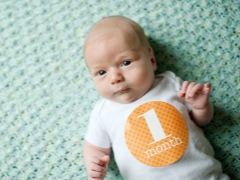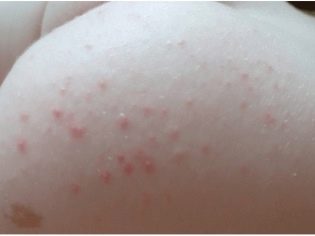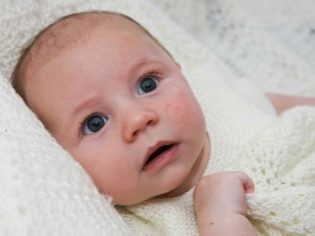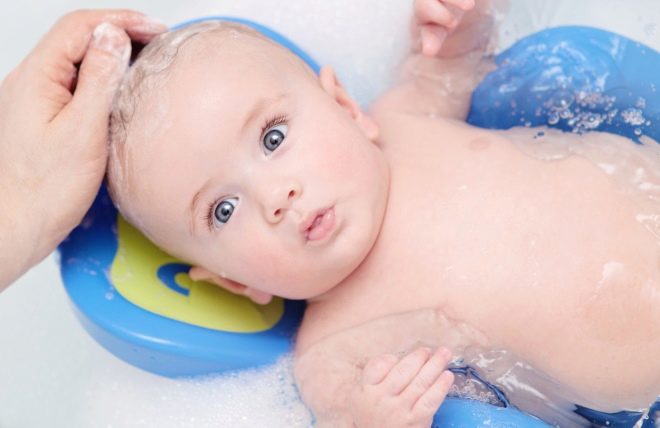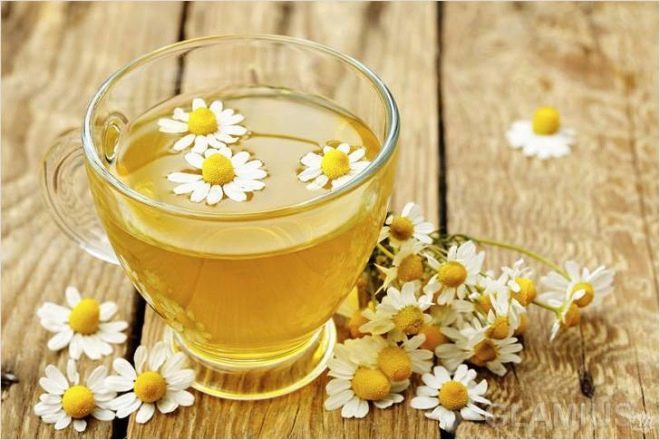Pimples on the face and body of newborns and infants
The delicate thin skin of a newborn baby is a matter of special admiration for parents. Therefore, it is not surprising that mothers and fathers begin to sound the alarm if a child has acne on the face from the first days of life. Why this happens and what to do with this problem, we will tell in this material.
What it is?
Acne from a newborn on the face may be single, and may take a fairly large area. Most often we are talking about white or yellowish zhirovichkah, but there are also red hollow eels. In medicine, it calls neonatal cephalic pustules. According to various sources, the problem is found in many babies, pimples appear in 20-35% of newborns.
Pimples usually appear on the nose, on the forehead, on the cheeks and chin of a child. Quite often, the rash appears in the scalp, as well as on the ears, behind them and on the neck. Even less often pimples appear on the chest. The nature of the rash itself may be different. If the skin is only yellow or white Wen, then it is - closed type comedoons. If black dots appear, which is not very typical for an early age, then these are open comedones. Purulent eels are pustules, and if eels look like small balls, the elevations above the skin without visible filling are papules.
Most often, neonatal pustulosis begins immediately after birth., as well as in the first month of independent life of the child. Less often - 3-4 months after birth and very rarely - by the end of the first year of life. Disease this phenomenon can not be considered. The problem is physiological in nature and usually goes away without a trace right after the natural causes that caused it are eliminated. The vast majority of babies have acne in a month after the first elements appear. In some children, it persists for 4-6 months.
Causes of
The causes of acne in early childhood is not fully understood.
The most convincing arguments are usually two provoking factors:
- hormonal processes in the body of infants;
- adaptation of the skin of the child to the new conditions of existence.
Hormonal processes cause estrogen, the female sex hormone, which the baby gets from the mother during pregnancy and during childbirth. This hormone causes an increased production of subcutaneous fat by the sebaceous glands, with the result that the pores are “clogged” by the secretion of the glands, the hair follicle and the gland itself are inflamed. The effect of maternal hormones on the body of infants does not last long - several months. Then the hormonal background of the child returns to normal and remains stable until adolescence. At 12-13 years old, the same processes will begin in the body, but they will only be caused by the child’s own sex hormones.
The second reason is adaptive processes. The baby’s skin in the nine months of pregnancy has become accustomed to contact in the aquatic environment, because in the womb the baby was surrounded by amniotic fluid. In the first weeks after birth, the crumbs of the skin are “rearranged” under the air, “learn” to work in a new mode. The process of debugging requires some time, and therefore the increased production of sebum is natural.
Subcutaneous fat - the body's defense, with its help the skin is protected from aggressive external influences. There is nothing surprising in the fact that the skin of a newborn is trying to protect the baby from external influence. The appearance of acne has nothing to do with hygiene issues.Therefore, “punishing” yourself for inadequate care, as a result of which the baby became covered in acne, is not worth it. It does not depend on the care.
When acne is a sign of disease
Acne of newborns is not a cause for concern, which is not the case for rashes, which are caused by dermatosis and some infectious diseases. Therefore, it is important for parents to learn to distinguish common pimples, the appearance of which, as we found out, is quite natural from the skin manifestations of a painful condition.
Pimples and blisters can appear with chickenpox, with herpes infection, with various dermatoses, and an allergic reaction. They can be a consequence of diaper dermatitis, if they are in the groin, contact dermatitis - if they coincide in location with the skin areas in contact with clothing, stitches on clothes. A careful and thoughtful examination of the child’s body will help distinguish neonatal acne from the manifestations of the disease:
- Localization. Harmless acne is located mainly on the cheeks, nose, forehead, chin, behind the ears, and occasionally - on the chest. An allergic reaction usually has a wider “geography”, extending to the body - on the stomach, back, skin folds, on the ass. Diaper dermatitis is limited to the diaper cover area. A viral infection can be localized in any part of the body, but it is never limited to just one part of the body. The exception is a simple virus herpes the first and second type, which usually affects the lips, nose, nasolabial triangle.
- Appearance of rash. Allergic rash looks like clusters of small red spots without purulent tops. A herpetic infection always looks like small blisters filled not with pus but with serous fluid. Such vesicles are characteristic of many viral infections, but are not characteristic of common neonatal acne.
- The behavior of the child. Physiological pimples do not give the baby any inconvenience. They do not itch, do not hurt, do not itch. To say the same about allergic dermatitis is impossible. In case of allergies, the child will show anxiety as the rash will itch. Itching and tingling sensations are also characteristic of many viral infections, especially herpes.
- The general condition of the child. With acne, there are no additional symptoms of the disease. Pimples do not affect the mood, sleep, appetite of the child. In case of an allergic reaction, the temperature may be slightly elevated, there is general malaise, drowsiness, indigestion or respiratory symptoms - a runny nose, cough. Viral infections always occur with high fever, symptoms of intoxication, loss of appetite and sleep patterns.
If you yourself is difficult to distinguish acne from a painful rash, do not be shy, you should call the doctor at home. The doctor will help to understand this difficult question and will give the necessary recommendations.
Diagnostics
Usually the specialist is quite enough visual inspection of the child. By characteristic appearance, the doctor easily distinguishes acne from other possible ailments. In doubtful cases, as well as with strong and deep acne rash, the doctor may recommend to pass a general analysis of the blood and the contents of the purulent "head" on bakposev. This will provide an opportunity to establish the exact appearance of the germ that caused the inflammation, as well as find out which type of antibiotics it is sensitive to.
In the people, this analysis is called the analysis of feces for dysbacteriosis. If the crumbs reveal abnormalities in the balance of bacteria that live in the intestines, drugs such as Bifidumbacterin can be prescribed to it, which will help to normalize the microflora.
Pediatricians quite often appoint infants with acne to examine the feces for the presence and characteristics of intestinal microflora.
Treatment
Neonatal acne does not require special treatment in a child. Almost always they pass on their own as the normal operation of the body of the crumbs.But caring parents cannot calmly look at the baby’s face covered with eels, they definitely need to do something to feel that they give the baby everything they need. Persuading moms and dads is useless - every pediatrician knows this. That is why there are certain recommendations that, although they do not affect hormonal processes, but somewhat facilitate the adaptation of a child’s skin to a new environment.
The quantity and quality of acne depends on the environment.therefore, it is important to create a microclimate for the child in which he will not sweat much, because excessive sweating creates prerequisites not only for blocking the pores with a sebaceous secret, but also for other, less harmless skin rashes. All newborns tend to sweat, because their thermoregulation is not yet debugged. The optimal conditions that mom and dad can create is the air temperature in the room not more than 20 degrees Celsius, as well as the relative humidity of the air at 50-70%. It is enough to buy a room thermometer and a special device - a humidifier. This purchase is more than useful, because the correct humidity in the room is also a great way to prevent respiratory diseases.
Bed linen in the newborn’s crib should be made from natural fabrics without the use of textile dyes. In the dream, the baby's head sweats more. Therefore, it is very important that the scalp and face contact only with natural tissues. Place a folded diaper under the head, pre-ironed by the iron. The diaper should be changed to fresh at least three times a day.
Properly chosen clothing will help reduce sweating. Baby do not need to muffle. At home, the baby may well be without a cap at all, and for a walk you should dress your baby strictly according to the weather. If the child is still sweating, for example, in winter overalls, you should bathe him in warm water without the use of detergents and baby soap immediately after returning from the street and change into dry clean linen.
It is possible to bathe the child with soap only once a day. And it is better not to use a piece of soap, but soapy water, which should be prepared before bathing. Anyone, even baby soap, dries the skin.
Often the use of detergents only provokes excessive production of subcutaneous fat, which the sebaceous glands will try to protect the skin from drying out.
If acne is accompanied by a crust on the face, do not remove it mechanically. It is enough to apply warm vegetable or peach oil to it 20 minutes before bathing. The softened crust will come off faster. White and black eels in an infant cannot be squeezed out, rubbed with alcohol, adult lotions and other cosmetics.
Acne rash can not be smeared with baby cream or other means on a fatty basis, because it additionally affects the blockage of skin pores and can lead to the appearance of new elements of the rash. It is not necessary to apply anti-acne remedies for older children, as well as antibiotics for delicate baby skin.
Be sure to keep in mind that the newborn has not yet formed its own, including local immunity, and therefore its skin is more difficult to cope with attacks of bacteria that are everywhere. That is why it is so dangerous to subject the skin to mechanical cleaning, the influence of drugs. Attached bacterial inflammation will not benefit the child, and traces that remain after squeezing acne may last for a lifetime, spoiling the appearance of the child.
Cotton pads, moistened with a decoction of chamomile pharmacy, you can apply for 10-15 minutes on the places most severely affected by acne. However, it should be remembered that medicinal plants can also cause allergies, so before using any herbal remedies, it is advisable to consult a pediatrician.
A baby is allowed to bathe and wash with water with a decoction of chamomile or a string added to it.
It is allowed to treat the rash with a weak solution of Chlorophyllipt. It is better to use the drug, which is sold in the form of an alcohol solution. Oil solution and spray for babies is not suitable. You should not carry out such procedures too often to avoid drying out of the skin. Children who are prone to allergies should not smear their face with this drug, because its vegetable components can exacerbate allergic manifestations.
The amount of acne is also affected by the hormone cortisone, which is produced in a person under stress. If the mother who feeds the baby is very nervous, then the baby gets cortisone with milk, which he doesn’t need by and large. Mom definitely needs to calm down and create favorable psychological conditions for herself and her baby.
After bathing, the baby’s skin should not be rubbed with a towel. It is easy enough to blot it, since intense mechanical stress can lead to micro-injury and subsequent infection with pathogenic bacteria.
Any redness on the skin of a baby causes parents to worry about what kind of rash babies can have, pediatrician Anna Ramonova will tell.
